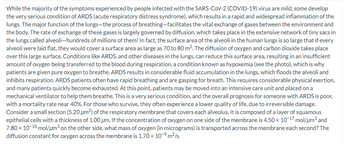
I believe I use the diffusion law on this: (Diffusion Constant × ∆Concentration × Area) / Thickness. Then change the constant into micrometers (x10^-12). Maybe use the fact that oxygen = 16 grams/mol. Am I on the right track? Thank you for any help you can provide.

![### Cyanosis: An Indicator of Hypoxemia
**Image Description:** The image shows a person's open hand with visible blue/purple coloration on the skin of the fingers and palm. This is indicative of a condition known as cyanosis.
**Explanation:**
Cyanosis is a common sign of hypoxemia, or low oxygen levels in the blood, which results in a noticeable blue or purple discoloration of the skin. This is often observed in peripheral areas like the fingers, toes, and lips. The change in color is due to an increased concentration of deoxygenated hemoglobin in the blood.
**Interactive Section:**
- **Number [Info Icon] [Input Box]**
- **Units [Dropdown Menu]**
This input function allows users to log or calculate related metrics, possibly for educational purposes or tracking symptoms.](https://content.bartleby.com/qna-images/question/d261088c-f753-45e4-ae14-7adbaf3c257c/c7449810-909d-40a7-a807-9f5d9ce64b0a/jnr3fqc_thumbnail.png)
Trending nowThis is a popular solution!
Step by stepSolved in 6 steps with 2 images

This is what I did: to find change in concentration: 7.80e-18 - 4.50e-17 = -3.72e-17
Then applied diffusions law: (1.70e-9 x -3.72e-17 *5.20) / 1.00e-6 = -3.28848e-19
to convert to micrograms = -3.28848e-19 * 16g/mol * 1e6 mg/g = -5.26237e-12 micrograms.
This is what I did: to find change in concentration: 7.80e-18 - 4.50e-17 = -3.72e-17
Then applied diffusions law: (1.70e-9 x -3.72e-17 *5.20) / 1.00e-6 = -3.28848e-19
to convert to micrograms = -3.28848e-19 * 16g/mol * 1e6 mg/g = -5.26237e-12 micrograms.
- 17. Muscle. Contractions which move the body depend heavily on diffusion. Why do we have difficulty moving our fingers etc. when they are cold ?arrow_forwardDiscuss why the following affect the rate of diffusion:molecular size, temperature, solution density, and thedistance that must be traveled.arrow_forwardPlate A = filter paper dipped into 5% solution of unknown Dye A %3D Plate B = filter paper dipped into 5% solution of unknown Dye B Both plates were incubated at 37°C. At the end of the 60 minute incubation period the diffusion rings for each dye were measured. The diffusion ring for Dye A = 40 mm. The diffusion ring for Dye B = 24 mm %3D Based on the results, which dye had the higher molecular weight? Explain your answer.arrow_forward
- Select the best option: In diffusion, substances move from areas of (greater) (lesser) to (greater) lesser concentrations.arrow_forwardhow many uL do i need to get 1ug of Dna? absorbance: 260 DNA: 1.05 Concentration: 20.4 ug/mlarrow_forwardPlease help me with this question within proper explaination that why the answer is 3arrow_forward
- How do I solve this problem? I tried everything, I need the answer.arrow_forwardPlease answer items number 1 to 6. This is not a writing assignment. Please have the answer encoded and not handwritten.arrow_forward9. What relationship exists between molecular weight and the rate of diffusion?arrow_forward
 Human Anatomy & Physiology (11th Edition)BiologyISBN:9780134580999Author:Elaine N. Marieb, Katja N. HoehnPublisher:PEARSON
Human Anatomy & Physiology (11th Edition)BiologyISBN:9780134580999Author:Elaine N. Marieb, Katja N. HoehnPublisher:PEARSON Biology 2eBiologyISBN:9781947172517Author:Matthew Douglas, Jung Choi, Mary Ann ClarkPublisher:OpenStax
Biology 2eBiologyISBN:9781947172517Author:Matthew Douglas, Jung Choi, Mary Ann ClarkPublisher:OpenStax Anatomy & PhysiologyBiologyISBN:9781259398629Author:McKinley, Michael P., O'loughlin, Valerie Dean, Bidle, Theresa StouterPublisher:Mcgraw Hill Education,
Anatomy & PhysiologyBiologyISBN:9781259398629Author:McKinley, Michael P., O'loughlin, Valerie Dean, Bidle, Theresa StouterPublisher:Mcgraw Hill Education, Molecular Biology of the Cell (Sixth Edition)BiologyISBN:9780815344322Author:Bruce Alberts, Alexander D. Johnson, Julian Lewis, David Morgan, Martin Raff, Keith Roberts, Peter WalterPublisher:W. W. Norton & Company
Molecular Biology of the Cell (Sixth Edition)BiologyISBN:9780815344322Author:Bruce Alberts, Alexander D. Johnson, Julian Lewis, David Morgan, Martin Raff, Keith Roberts, Peter WalterPublisher:W. W. Norton & Company Laboratory Manual For Human Anatomy & PhysiologyBiologyISBN:9781260159363Author:Martin, Terry R., Prentice-craver, CynthiaPublisher:McGraw-Hill Publishing Co.
Laboratory Manual For Human Anatomy & PhysiologyBiologyISBN:9781260159363Author:Martin, Terry R., Prentice-craver, CynthiaPublisher:McGraw-Hill Publishing Co. Inquiry Into Life (16th Edition)BiologyISBN:9781260231700Author:Sylvia S. Mader, Michael WindelspechtPublisher:McGraw Hill Education
Inquiry Into Life (16th Edition)BiologyISBN:9781260231700Author:Sylvia S. Mader, Michael WindelspechtPublisher:McGraw Hill Education





